A brief history of Luxman
Founded in 1925, Luxman dates from the dawn of radio broadcasting and stands as one of the world’s oldest consumer electronics companies. In the 1960s, when mass-market high fidelity abandoned vacuum tubes in favor of transistors, Luxman recognized the characteristic warmth and musicality of tube reproduction. And we’ve continued to make tube amplifiers without interruption. Our legacy in vacuum tube electronics includes an all-star roster of former designers who went on to establish their own companies, entirely separate from Luxman. These include Tim de Paravicini (EAR Yoshino), Atsushi Miura (Air Tight), Taku Hyodo (Leben) and Junji Kimura (47 Laboratory).
In the 1970s and 80s, Luxman components gained international recognition for sumptuous music reproduction, meticulous engineering, robust build quality and understated design. Now based in Yokohama, Luxman offers a carefully curated range of high-end audio to discerning music lovers in 48 countries on five continents.
Early days
Luxman began in the unlikeliest of places, the Kinsuido Picture Frame Store in Osaka, Japan. There, the Hayakawa brothers established a radio department in 1925, anticipating the birth of radio broadcasting in Japan. Kinsuido was the first company in Japan to display and sell radio receivers – astonishing visitors with the quality of sound. To fulfill an urgent need for a Japanese-language reference on radio technology, the company published the Kinsuido Radio Book, with the catch phrase, “Reading once makes you the radio expert.” Self-published at first, the book became a best seller, going through 14 editions and inspiring generations of audio engineers. To secure a supply chain, the brothers needed to make international connections and traveled outside Japan. The company quickly transitioned from simply importing radio parts and equipment to manufacturing parts and assembling its own products in-house, marking the birth of the Luxman brand.
Product and technology milestones

- 1925
- 1928
- 1928
- 1931
- 1952
- 1958
- 1961
- 1962
- 1964
- 1966
- 1975
- 1975
- 1977
- 1979
- 1981
- 1980
- 1982
- 1982
- 1985
- 1986
- 1987
- 1987
- 1987
- 1988-89
- 1988-89
- 1989
- 1990
- 1991
- 1996
- 1999
- 2001
- 2004
- 2014
- 2015
- 2016
- 2019
First retail display of radio receivers in Japan. Publish the Kinsuido Radio Book
LUX-735 radio set with magnetic speaker
LUX-1730 electric phonograph
Original magnetic phono pickup
Original OY-type output transformer, built to surpass the performance of imported parts
Patented cross-over Negative Feedback circuit, featured in the MA-7A vacuum tube amplifier
An instant classic in Japan, the SQ-5A vacuum tube integrated amplifier incorporates a proprietary tone control circuit and a front-panel level meter.
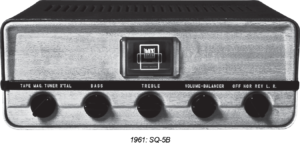
Patented motion-feedback technology in the SQ-65 vacuum tube integrated amp optimizes the output based on feedback from the loudspeaker.
An audiophile icon and staple of Japanese jazz cafes, the SQ-38 vacuum tube integrated amplifier inspires a legacy that includes the SQ-38D, 38F, 38FD and even a 70th anniversary model, the SQ-38S of 1995.
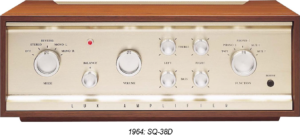
Luxman creates a vacuum tube amplifier without an output transformer, the output transformer-less (OTL) design of the MQ-86
Celebrating the company’s 50th anniversary, Luxman introduces a high-end transistor series designed by Tim de Paravicini. The M-6000 power amplifier features 300 watts per channel, massively overbuilt heat sink stacks, a giant power transformer and prominent stereo VU meters supplemented by peak LEDs. Together with the matching C-1000 preamp and T-110 AM/FM tuner, the M-6000 wins international acclaim among demanding music lovers.
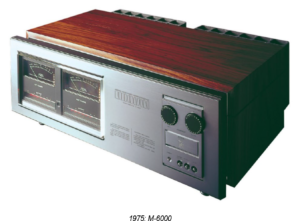
PD-121 direct drive turntable features an anti-resonant chassis with exemplary performance
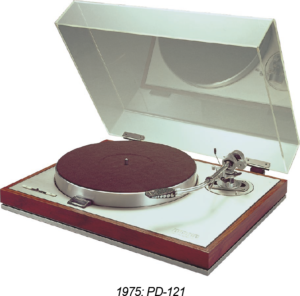
The world’s first DC amplifier configuration arrives in the 5M21 power amp, part of the Laboratory Reference Series that also includes the revolutionary 5T50 frequency synthesis FM tuner and 5G12 equalizer.
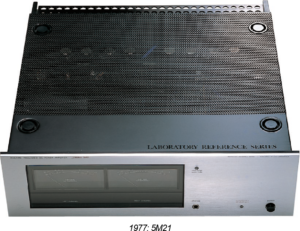
L-58A is among the very first integrated amplifiers to incorporate metal oxide semiconductor field effect (MOSFET) output transistors.
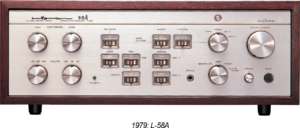
L-550 integrated amplifier combines Class A design with Luxman’s patented Duo-Beta circuitry, which optimizes open loop performance and eliminates DC offset. This enables engineers to minimize negativfeedback and achieve extremely wide bandwidth and low Transient Intermodulation Distortion. Duo-Beta leads to Duo-Beta/S, ONDF (Only Distortion Negative Feedback) and today’s ONDF 4.0.
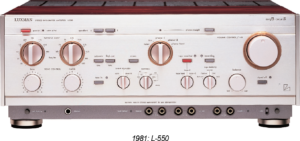
The Vacuum Disc Stabilizer (VDS) of Luxman’s PD-300 turntable is a breakthrough in analog playback. It minimizes the audible distortions of record warp and resonance by holding the disc tight to the platter surface.
The North America-only RX-103 Servo Face receiver introduces visual flair with a motorized front panel that recedes to reveal controls and buttons.
X-3K cassette deck, a Japanese domestic market project with “omega drive” transport mechanism that pulls the tape from the cassette, wrapping it around the head block. Achieves sound quality comparable to open reel tape.
BRID Series of hybrid vacuum tube-MOSFET output components launches with the LV-105 integrated amplifier and the matching D-105u CD player.
Five-year parts & labor warranty launches, unique at the time. This is made possible by then-parent company Alps Electric’s expertise in satisfying the super-stringent quality control requirements of customers like Honda.
The Alpine/Luxman CD shuttle enables easy cartridge interchange between the Luxman DC-114 home changer and the Alpine 5952 car changer.
Luxman’s first Fluency digital-to-analog converter arises from original research by Kazuo Toraichi and associates at the University of Tsukuba and Seikei University. The system uses interpolation to achieve spectacular time-domain performance. It first appears in the DA-07 D-to-A converter, companion to the DP-07 CD transport. Learning from the Fluency DAC informs Luxman CD player designs to this day.
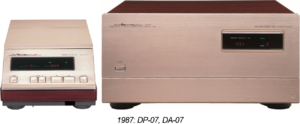
KD-117 Digital Audio Tape recorder enables home audio recording of superb quality.
Luxman helps launch the custom A/V installation business with the TP-117 multi-zone tuner-preamp designed by Tom Cumberland. This distributes audio and composite video via dedicated cables with 10-pin connectors, offers IR-based multi-room controllers and works with companion power amps.
R-117, 115 and 113 receivers combine the frequency synthesis tuning expertise of Alpine with Luxman’s traditional amplifier design. Renowned for sound quality, these models are still sought after.
L-570 integrated amplifier operates in Pure Class A mode and achieves 50 watts per channel.
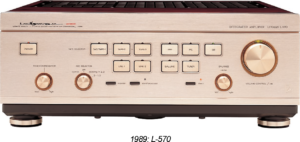
F-105 Dolby® Pro-Logic™ surround sound processor incorporates three channels of amplification for combination with an existing two-channel system.
At Chicago’s Summer Consumer Electronic Show, the company demonstrates multi-room A/V with audio playback through Luxman in-wall loudspeakers.
Luxman advances the technology of volume control with the Quadruple Super Ultimate Attenuator of the flagship C-10 control amplifier. It uses an array of 456 high-precision fixed resistors.
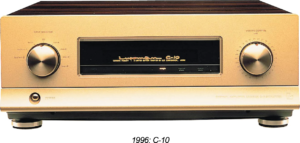
World’s first Only Distortion Negative Feedback (ODNF) circuit is incorporated into the CM-2100 in-car power amplifier. This is badged as Luxman or Alpine, depending on the country.
The “universal” high-end player, the DU-10 supports CD, SACD, DVD Video and DVD Audio.
CL-88 and MQ-88 preamp and power amp embody a fresh approach to vacuum tube audio.
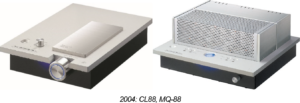
Using four pairs of parallel push-pull power transistors per channel, the M-900u power amplifier bridges to deliver 600 watts monaural into an 8-ohm load. ONDF (Only Distortion Negative Feedback) V4.0 minimizes distortion while achieving wide bandwidth, quick response and relaxed, natural sound.
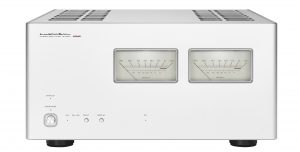
MQ-300 power amplifier celebrates Luxman’s 90th anniversary with direct heated TA-300B triodes. Design touches include engraved nameplates on the transformer cases and a piano finish natural walnut frame.
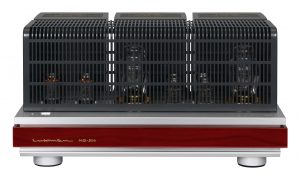
DA-250 USB digital-to-analog converter supports both DSD and PCM signals and incorporates LECUA computerized attenuator.
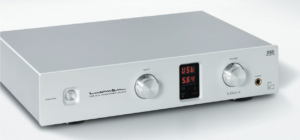
LECUTA, the Luxman Electronic Ultimate Transformer Attenuator, debuts on the CL-1000 preamplifier.
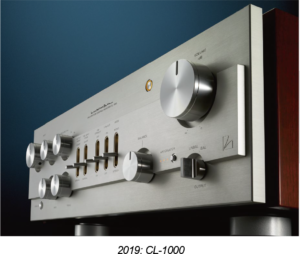
Corporate milestones
- 1925
- 1971-80
- 1972
- 1984
- 1994
- 2000
- 2009
- 2017
Founded as the Radio Department of Kinsuido Picture Frame Store, Osaka, Japan.
Offered Lux-Kit brand turntables, vacuum tube and transistor amps to satisfy value-conscious music lovers who were turning to kit hi-fi.
Launched L&G lifestyle brand of fashionable audio systems.
Merged with global electronic parts supplier Alps Electric Co. Ltd. to form Alpine-Luxman. Alps had achieved international status meeting the demanding quality control requirements of customers such as Apple and Honda. Established a US marketing organization under Alpine of America.
As Alpine focused on developing GPS navigation, joined Korean electronics giant Samsung
Became a private company.
Joined International Audio Group Ltd., parent company of revered British brands Quad Electroacoustics, Mission, Leak and Wharfedale.
Established Luxman America subsidiary in Ballston Spa, New York.
















